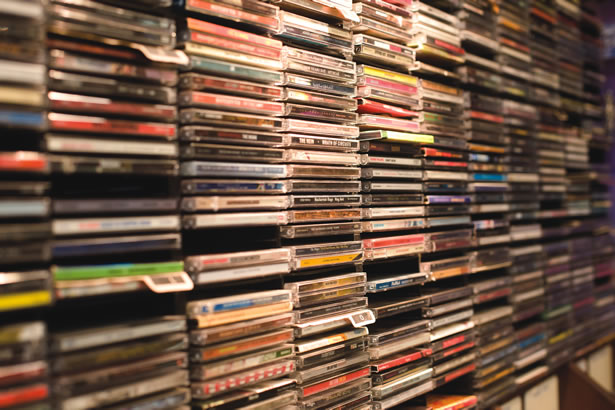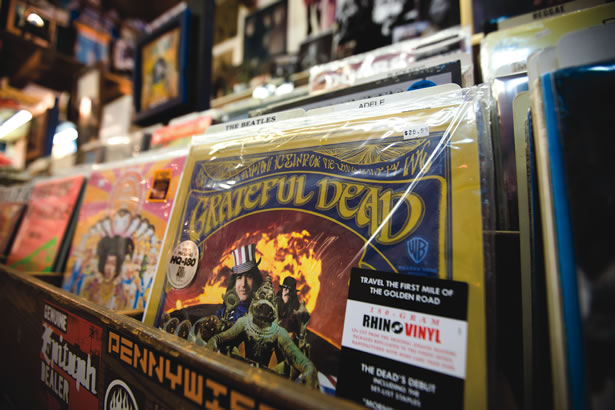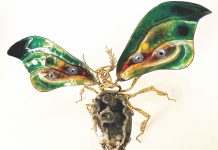Thanks to a resurgence of vinyl and good old-fashioned customer service, Jim Otto and Sound Spectrum continue to be a Laguna Beach mainstay since 1967.- By Bruce Porter | Photos by Dondee Quincena
 Many major labels have declared bankruptcy, and the few survivors continue to struggle. Chain store retailers, like the once mighty Tower Records, are long gone, replaced by Walmart, Best Buy and the iTunes store. Perhaps most disheartening, over the course of a single decade more than half of the independent record stores in the U.S. have also called it quits.
Many major labels have declared bankruptcy, and the few survivors continue to struggle. Chain store retailers, like the once mighty Tower Records, are long gone, replaced by Walmart, Best Buy and the iTunes store. Perhaps most disheartening, over the course of a single decade more than half of the independent record stores in the U.S. have also called it quits.
Fortunately, Laguna record store owner Jim Otto has weathered the storm of progress. “The Internet, to a certain extent, almost has too much data for someone who’s just trying to find their way in the world of music,” Jim says. “Going to a place where you can find someone who knows and cares about the music is a dying breed—it’s becoming harder and harder to find.”
Walking Back in Time
Sound Spectrum is a throwback to another generation—a quaint, dusty old record shop with a satisfying mix of modern and classic bands. There are posters of the Black Keys, the Doors and Bob Marley lining its walls. It’s a place where idealistic teenagers and serious audiophiles come together, not only thumbing through CDs and rare vinyl, but analyzing, debating and propagating cultural trends—often in stark contrast to the mainstream.
Jim and two partners opened the store in a converted old house at the height of the ’60s counterculture movement. “We attended the Monterey Pop Festival, so that was inspirational,” Jim says. Then, with a wink and nod, he adds, “It was definitely the Summer of Love.”
He describes Laguna during this turbulent period with great affection. “We opened in ’67,” Jim says. “Things were going on around us, society was changing. Stuff happened here that didn’t happen anywhere else. There were some really amazing stores that aren’t around anymore.”
But not every youngster of the era who wore tie-dye T-shirts and protested Vietnam went on to start a business. “There wasn’t a cool, hip record store in Laguna,” Jim explains. “There was a record store, but it was more classical and jazz. I really loved music, and I liked the retail experience. My father was in retail, so it seemed natural to put those two things together.”
Record stores have historically been a launching pad for aspiring musicians and artists. Sound Spectrum, as Jim will proudly tell you, has had its fair share of interesting characters and success stories. Timothy Leary’s son Jack worked there at the time when President Richard Nixon called Timothy “the most dangerous man in America.” One former employee, Robert Santelli, went on to write several books, including biographies of Bruce Springsteen and Woody Guthrie, become the curator at the Rock and Roll Hall of Fame Museum, and now works at the Grammy Museum in Los Angeles.
“They usually start because they like a certain kind of music, and they’re really involved in it,” Jim says. “And nothing could be better than working in a record store listening to your favorite bands. But what happens is, with people talking about other music, they hear stuff they wouldn’t ordinarily listen to, and they find their musical tastes changing and evolving.”
Knowledge is never Out of Style
A good deal of Sound Spectrum’s longevity can be credited to Jim and his knowledgeable staff. “If you go into your favorite bookstore, and the person behind the counter is able to open your eyes to a whole new kind of fiction, or a new author, then you’re going to want to go back,” he says. “It’s the same thing with record stores.”
Jim’s a veritable encyclopedia of pop music. He’s apt to inform customers that Jimi Hendrix was also an accomplished painter, though he often crumpled up the finished pieces and threw them away. Jim also notes that the cover art of the Clash’s “London Calling”—the seminal punk double album released in 1979—is a tribute to Elvis Presley’s debut record.
“It’s interesting,” he says, pointing out the similarities. “The same colors, the same layout. The Clash thought this was the first rock ’n‘ roll album, Elvis the first rock ’n‘ roll star, and that they were the first punk band, so they used those images.”
With a small measure of friendly encouragement, Jim is happy to recount trivia about nearly every album in the store. In addition to his role as a musical tour guide, he also hosts “Reggae Showcase” on KSBR 88.5 FM on Sunday afternoons from 3 to 6 p.m.
Darwinian Rock ’n‘ Roll
“I find the ones that survive,” Jim says of indie record shops, “are the ones that give extra service, or the ones that have the one thing you can’t find anywhere else.” Loyal Sound Spectrum customers cite helpful tips, like how to keep vinyl clean, listening stations so they can check out used CDs before buying, and an extensive collection of rock ’n‘ roll memorabilia.
The store is chock-full of out-of-print posters, postcards, T-shirts, badges, Zippos with band logos, groovy hippie jewelry and assorted oddball stuff like a bottle of wine with a Grateful Dead label. Through the lean years, Jim says these items helped keep the store afloat. But the unlikely lifeline for indie shops continues to be returning customers flocking to vinyl with a passion.
“A good thumbnail look at the evolution of my record store is if you look at the center racks,” Jim says. “These are my original racks, and over the years we put the dividers in for CD racks. Now, as records are coming back, I’ve taken the dividers out and put the records back.”
Although vinyl never completely went out of fashion, especially with collectors, the latest generation of music lovers has discovered the benefits of analog recordings. There have been significant advances in analog technology, and vinyl today is thicker than it used to be, making it far less likely to warp.
Whether they have a collection of high-end audio equipment at home or not, people are gravitating back to vinyl simply for the comfort of the physical product. Vinyl collectors enjoy the larger cover art and liner notes. There’s a greater sense of connecting with the artist.
It’s a growing trend the record labels have noted and have taken steps to encourage.
Vinyl now comes in a variety of attractive colors. Reissues get re-mastered, further improving the sound quality. And now, more often than not, vinyl records come with a download code, so buyers can have the best of both worlds—MP3s for their iPods and physical copies for home entertainment.
Reversing the Trend
For years, vinyl record sales were flat, but in 2006, there was a perceptible uptick for the marginalized format. This year, for the first time since the dawn of Internet downloading, there were more independent record stores opening than closing. “Some days I do more sales with vinyl records than compact discs,” Jim explains. “That’s a big change.”
All the industry talk aside, what really gets Jim excited is still the music. “What I always try to stress is that it’s good music, not a certain kind,” he says. “I think that still holds true, whether it’s alternative or alt folk, hip-hop or jazz fusion. We’ve seen all these changes come down the pike, and all the good artists, the inventive performers rise to the surface.”
And for people who are unable to spend half their lives sifting through silt to find gold, Jim’s experience is an invaluable resource. “It’s easy in hindsight (to recognize a quality act), but while it’s happening there’s always so much music pouring out. We’re like a museum curator; we’re selective about what we carry and play in the store.”
You can find Jim at Sound Spectrum, located at 1264 S. Coast Hwy.; 949-494-5959; soundspectrumlaguna.com. LBM






